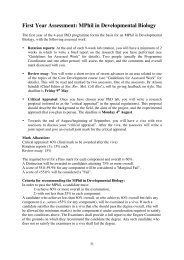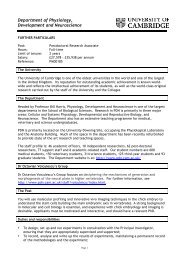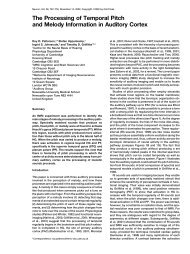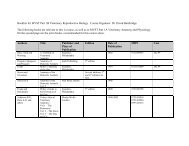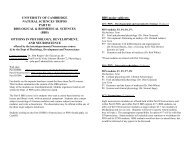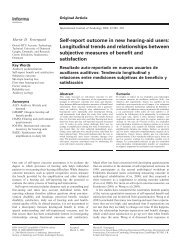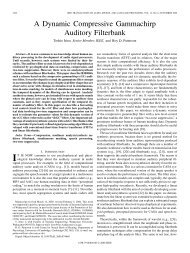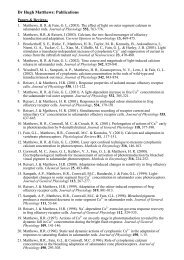part ii physiology, development and neuroscience - Department of ...
part ii physiology, development and neuroscience - Department of ...
part ii physiology, development and neuroscience - Department of ...
You also want an ePaper? Increase the reach of your titles
YUMPU automatically turns print PDFs into web optimized ePapers that Google loves.
Eye Movements<br />
This practical is associated with Module N3, <strong>and</strong> preference will be given to students who<br />
are taking it:<br />
In this class we look at the saccades made while reading, a highly skilled saccadic performance<br />
that lends itself to study in the laboratory. We will be trying to answer two kinds <strong>of</strong> problem, one<br />
low-level, the other high. To what extent the saccades made in reading are determined by<br />
detailed aspects <strong>of</strong> the visual stimuli provided by the letters? Can we for example produce<br />
objective evidence that some fonts are easier to read than others, or how big the text should be<br />
for optimum reading? ‘Higher’ questions include finding out to what extent the meaning <strong>of</strong> the<br />
text influences the size <strong>and</strong> timing <strong>of</strong> the saccades, <strong>and</strong> how they are affected by any responses<br />
that are to be made to it (as for example in reading music).<br />
This practical is associated with Module N6, <strong>and</strong> preference will be given to students who<br />
are taking it:<br />
This practical is an in-depth investigation <strong>of</strong> the mechanisms underlying decision. Deciding<br />
where to look is the commonest decision any <strong>of</strong> us makes (some three decisions a second on<br />
average!); since saccades can be measured non-invasively <strong>and</strong> robustly, over the last decade<br />
measurements <strong>of</strong> saccades using carefully-designed experimental protocols has provided a<br />
great deal <strong>of</strong> information about decision mechanisms in general. In this class we will see how a<br />
series <strong>of</strong> systematic experiments can establish some fundamental facts about these<br />
mechanisms, using automated computer-based techniques <strong>of</strong> data-acquisition <strong>and</strong> analysis to<br />
test hypotheses concerning the neural mechanisms initiating visual saccades.<br />
Pr<strong>of</strong>. Roger Carpenter<br />
22



